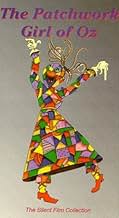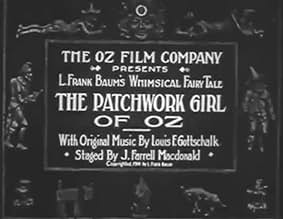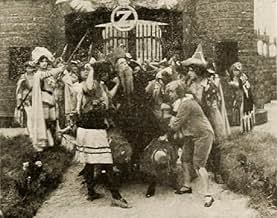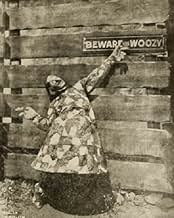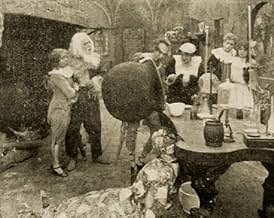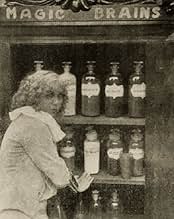Aggiungi una trama nella tua linguaOjo and Unc Nunkie are out of food, so they decide to journey to the Emerald City where they will never starve.Ojo and Unc Nunkie are out of food, so they decide to journey to the Emerald City where they will never starve.Ojo and Unc Nunkie are out of food, so they decide to journey to the Emerald City where they will never starve.
Leontine Dranet
- Margolotte, his wife, who makes the Patchwork Girl
- (as Haras Dranet)
Richard Rosson
- Danx, a Noble Munchkin
- (as Dick Rosson)
Bert Glennon
- The Scarecrow
- (as Herbert Glennon)
Hal Roach
- The Cowardly Lion
- (as Al Roach)
- …
Dave Anderson
- The Hungry Tiger
- (as Andy Anderson)
Pierre Couderc
- Scraps, the Patchwork Girl
- (as The Marvelous Couderc)
Recensioni in evidenza
You really have to look at "The Patchwork Girl of Oz" in context, otherwise you'll just dismiss it as a dull and incomprehensible movie. But, back in 1914, it was a rather impressive tale--but one that even audiences back then probably struggled to understand unless they'd read the Frank Baum story. Heck, I tried watching it was was TOTALLY confused until I read a summary of the story on the internet! That's because the narrative is really scant--with almost no intertitle cards. Instead, it's shown as a series of tenuously connected vignettes which are described on the card and then acted out...as was the style up until about 1914 or a bit later. It comes off almost like a slide show that is acted out for the audience! This certainly is NOT all that entertaining and too often the characters just cavort about aimlessly or do acrobatics instead of acting--and it comes off pretty poorly. BUT, again, it was pretty much the style of the day. The ladies in the film and sets and 'magic' were pretty similar to the work done a decade earlier by the groundbreaking French film maker Georges Méliès. By 1914, these amazing effects and story telling really were a a bit passé--definitely on their way out--which might explain why the film was a critical flop--that, and the fact that the audience probably had no idea what was occurring on screen! Interesting from a historical perspective and having excellent production values for the time, but still very easy to skip unless you adore very early silent films.
The most famous movie adaptation of a novel by L. Frank Baum entails Toto, a tornado, ruby slippers and a yellow brick road. Well, it turns out that Victor Fleming's 1939 adaptation was not the first. An earlier screen version of "The Wizard of Oz" was a 1925 loose adaptation of the story, notable for casting Oliver Hardy as the Tin Woodsman.
And then there were the adaptations in which Baum himself participated. He founded the Oz Film Manufacturing Company and made some movie versions of his novels. These aren't the most sophisticated adaptations but are worth seeing as a look into early cinema. "The Patchwork Girl of Oz" features things like people getting turned into statues (and one of them getting shrunken down so that a woman can carry him). Yeah, Baum came up with some wacky stuff.
One interesting thing about this movie is that the lion is played by none other than Hal Roach, best known as the producer of Laurel & Hardy's movies. It appears that only Stan Laurel didn't get to go to Oz on the silver screen. Of course, I can't picture him in Oz without imagining that he would have turned everything upside down. In other words, it would have been another fine mess that he'd gotten himself into!
Anyway, this movie is worth seeing. I wonder what Baum would have thought of the most famous adaptation of his work, had he lived to see it.
And then there were the adaptations in which Baum himself participated. He founded the Oz Film Manufacturing Company and made some movie versions of his novels. These aren't the most sophisticated adaptations but are worth seeing as a look into early cinema. "The Patchwork Girl of Oz" features things like people getting turned into statues (and one of them getting shrunken down so that a woman can carry him). Yeah, Baum came up with some wacky stuff.
One interesting thing about this movie is that the lion is played by none other than Hal Roach, best known as the producer of Laurel & Hardy's movies. It appears that only Stan Laurel didn't get to go to Oz on the silver screen. Of course, I can't picture him in Oz without imagining that he would have turned everything upside down. In other words, it would have been another fine mess that he'd gotten himself into!
Anyway, this movie is worth seeing. I wonder what Baum would have thought of the most famous adaptation of his work, had he lived to see it.
A feast of quaint but super-hectic activity, presented before a solidly stationary camera (except for the effective concluding shot), this is a dated and none too interesting attempt by author L. Frank Baum himself to transfer his Oz from the printed page to the cinema. He is let down by the totally unimaginative direction (from well-known character actor J. Farrell MacDonald), the almost entirely stationary camera-work (though there are a couple of clever touches here and there) with its long, boring takes, and the inappropriately over-the-top enthusiasm of almost all the players.
As a curiosity, the movie would make a tolerable two-reeler, but 65 minutes of repetitious jumping, sliding, running, kicking, dancing, climbing, gallivanting, funning and frolicking, is, despite the picturebook tints and novel costumes of its picturebook illustrations brought to life, just far too much of a mediocre thing.
Now, if the highly imaginative original drawings by W.W. Denslow that accompanied Baum's first and most famous venture into the land of Oz, The Wonderful Wizard of Oz (1900), had been brought to life rather than the conventional Victoriana here displayed, the film would doubtless have captured an audience's interest far more than this ultimately wearisome parade. Unfortunately, there was no chance of that happy eventuality. Baum and Denslow had a falling out in 1901 when both men claimed that the instant success of Oz was primarily due to their own input. Therefore it's no surprise that producer Baum made it his business to ensure the movie's visuals were as far removed from Denslow's creations as possible.
As a curiosity, the movie would make a tolerable two-reeler, but 65 minutes of repetitious jumping, sliding, running, kicking, dancing, climbing, gallivanting, funning and frolicking, is, despite the picturebook tints and novel costumes of its picturebook illustrations brought to life, just far too much of a mediocre thing.
Now, if the highly imaginative original drawings by W.W. Denslow that accompanied Baum's first and most famous venture into the land of Oz, The Wonderful Wizard of Oz (1900), had been brought to life rather than the conventional Victoriana here displayed, the film would doubtless have captured an audience's interest far more than this ultimately wearisome parade. Unfortunately, there was no chance of that happy eventuality. Baum and Denslow had a falling out in 1901 when both men claimed that the instant success of Oz was primarily due to their own input. Therefore it's no surprise that producer Baum made it his business to ensure the movie's visuals were as far removed from Denslow's creations as possible.
The enjoyable story and characters in "The Patchwork Girl of Oz" makes it a fun movie to watch, and it is also pretty resourceful for its era. It does have a lot of rough edges and shows some signs of age, but its energy and creativity more than make up for those. As with all of the Oz features made by L. Frank Baum's own studio, it shows his influence in the way that the fantasy world of Oz is brought to life with enthusiasm.
As with most of Baum's Oz stories, it has plenty of oddball characters and offbeat developments. A couple of odd casting choices add to the curious feel, with Pierre Couderc making Scraps look much like a male, and Violet Macmillan making Ojo seem more like a young girl. But they and the rest of the cast give their characters plenty of life, which really is more significant in a movie like this. As in the other Oz movies in the series, Fred Woodward also gets to perform a number of his costumed animal characters.
The story is one of Baum's most creative ones, telling a complex story in which the agendas and motivations of many different characters come into conflict. This adaptation is imaginative in using a lot of different techniques to reproduce the look of the characters, the magical events, and the hectic activity.
Much of it works rather well, and all of it represents a very good attempt for its time. Very few film-makers of the era ever tried to make a full-length picture out of such challenging fantasy material, and even if it has a fair number of rough edges, it remains a worthwhile and entertaining effort.
As with most of Baum's Oz stories, it has plenty of oddball characters and offbeat developments. A couple of odd casting choices add to the curious feel, with Pierre Couderc making Scraps look much like a male, and Violet Macmillan making Ojo seem more like a young girl. But they and the rest of the cast give their characters plenty of life, which really is more significant in a movie like this. As in the other Oz movies in the series, Fred Woodward also gets to perform a number of his costumed animal characters.
The story is one of Baum's most creative ones, telling a complex story in which the agendas and motivations of many different characters come into conflict. This adaptation is imaginative in using a lot of different techniques to reproduce the look of the characters, the magical events, and the hectic activity.
Much of it works rather well, and all of it represents a very good attempt for its time. Very few film-makers of the era ever tried to make a full-length picture out of such challenging fantasy material, and even if it has a fair number of rough edges, it remains a worthwhile and entertaining effort.
The recent phenomenon of Harry Potter isn't so unusual. An early case it the amazing popularity of Oz.
The books, the first ones, became popular, amazingly so. By some measures more popular than Potter. They are simple: children, a magical land rather a land like ours in many ways but with magic and magical creatures.
Then the movies started. Magic sells cinematically when the world is like the one we live in plus magic that matches what the camera can emulate. When the writer understands the overlap, he or she can write books that are cinematically rooted. Each feeds the other. Each feeds the juvenile imagination.
You should watch this. Because with distance, you can see how shallow that imagination is. The effects of today's movies are better, but they are no less believable to us than these were in their day. Let that soak in and you'll get pretty depressed about the current Potter phenomenon (and probably increase your appreciation for the "Rings" works).
Ted's Evaluation -- 2 of 3: Has some interesting elements.
The books, the first ones, became popular, amazingly so. By some measures more popular than Potter. They are simple: children, a magical land rather a land like ours in many ways but with magic and magical creatures.
Then the movies started. Magic sells cinematically when the world is like the one we live in plus magic that matches what the camera can emulate. When the writer understands the overlap, he or she can write books that are cinematically rooted. Each feeds the other. Each feeds the juvenile imagination.
You should watch this. Because with distance, you can see how shallow that imagination is. The effects of today's movies are better, but they are no less believable to us than these were in their day. Let that soak in and you'll get pretty depressed about the current Potter phenomenon (and probably increase your appreciation for the "Rings" works).
Ted's Evaluation -- 2 of 3: Has some interesting elements.
Lo sapevi?
- QuizHarold Lloyd and Hal Roach, who both have minor roles in this film, met on this set in San Diego. Roach was impressed by Lloyd's energy and sought him out when he formed his production company The Rolin Film Company in July 1914 after receiving a small inheritance. Although their association was stormy, their association was ultimately one of the most successful in silent film history.
- BlooperThe character of Ojo is stated several times to be a boy, but is referred to as a girl in one of the dialogue caption cards.
- ConnessioniFeatured in American Masters: Harold Lloyd: The Third Genius (1989)
I più visti
Accedi per valutare e creare un elenco di titoli salvati per ottenere consigli personalizzati
- How long is The Patchwork Girl of Oz?Powered by Alexa
Dettagli
- Tempo di esecuzione1 ora 21 minuti
- Colore
- Mix di suoni
- Proporzioni
- 1.33 : 1
Contribuisci a questa pagina
Suggerisci una modifica o aggiungi i contenuti mancanti

Divario superiore
By what name was The Patchwork Girl of Oz (1914) officially released in Canada in English?
Rispondi


